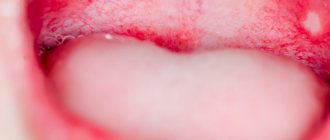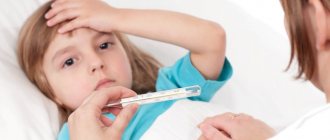Diathesis is a controversial concept. In modern domestic pediatrics and therapy, this concept is no longer used in everyday practice. Diathesis is essentially the body’s predisposition to the development of certain pathological reactions. Diathesis is also called constitutional anomalies. Previously, three types of diathesis were distinguished: exudative-catarrhal, lymphatic-hypoplastic, neuro-arthritic. Each of them included certain criteria. Exudative-catarrhal diathesis is characterized by a person’s tendency to allergies and the development of infectious diseases. Lymphatic-hypoplastic diathesis is characterized by excess weight, enlarged lymph nodes, enlarged tonsils and adenoids. Such children often suffer from respiratory diseases and are also prone to allergies. Neuro-arthritic diathesis is characterized by changes in metabolism caused by increased excitability of the nervous system. Such people often experience pain in the knees and back, urinary incontinence, night terrors, decreased appetite, emotional instability, and stuttering. It is worth emphasizing that the most characteristic symptom of this disease is cyclically occurring vomiting (the so-called acetonemic syndrome in children). The described symptoms of diathesis often occur in childhood, so these manifestations are less pronounced in adults.
Using the term “diathesis” nowadays, pediatricians and therapists often mean exudative-catarrhal diathesis, which has a more modern concept – “ atopic dermatitis”. Therefore, further consideration of this topic will be devoted to this particular disease.
What does diathesis lead to?
If an exacerbation is not treated in time, the child’s allergic diathesis can become chronic.
In addition, allergic diathesis is the first stage of the atopic march. The atopic march is the sequential development in the same child of first atopic dermatitis, then allergic rhinitis, and by the age of 5-6 years - bronchial asthma. Therefore, the outcome of the entire atopic disease, in particular the development of bronchial asthma, largely depends on the treatment tactics of atopic dermatitis.
Why should you contact the Mama Papa Ya clinic?
When a child has diathesis, it is important to pay attention to the little things - organizing nutrition, care, drawing up an individual vaccination calendar, a regime of hardening procedures, and so on. Often an examination by specialized specialists is required. The network of family clinics “Mama Papa Ya” offers medical services for the prevention and treatment of diathesis. By contacting one of our clinic branches located in Moscow or other cities, you will receive:
- consultation with a qualified pediatrician on all issues of interest;
- necessary diagnostic and treatment procedures;
- visiting all the necessary doctors in one clinic;
- possibility of observing children of different ages.
Make an appointment with a doctor by phone or on our website.
Reviews
Good clinic, good doctor!
Raisa Vasilievna can clearly and clearly explain what the problem is. If something is wrong, she speaks about everything directly, not in a veiled way, as other doctors sometimes do. I don’t regret that I ended up with her. Anna
I would like to express my gratitude to the staff of the clinic: Mom, Dad, and me. The clinic has a very friendly atmosphere, a very friendly and cheerful team and highly qualified specialists. Thank you very much! I wish your clinic prosperity.
Anonymous user
Today I had a mole removed on my face from dermatologist I.A. Kodareva. The doctor is very neat! Correct! Thanks a lot! Administrator Yulia Borshchevskaya is friendly and accurately fulfills her duties.
Belova E.M.
Today I was treated at the clinic, I was satisfied with the staff, as well as the gynecologist. Everyone treats patients with respect and attention. Many thanks to them and continued prosperity.
Anonymous user
The Mama Papa Ya clinic in Lyubertsy is very good. The team is friendly and responsive. I recommend this clinic to all my friends. Thanks to all doctors and administrators. I wish the clinic prosperity and many adequate clients.
Iratyev V.V.
We visited the “Mama Papa Ya” Clinic with our child. A consultation with a pediatric cardiologist was needed. I liked the clinic. Good service, doctors. There was no queue, everything was the same price.
Evgeniya
I liked the first visit. They examined me carefully, prescribed additional examinations, and gave me good recommendations. I will continue treatment further; I liked the conditions at the clinic.
Christina
The doctor carefully examined my husband, prescribed an ECG and made a preliminary diagnosis. She gave recommendations on our situation and ordered additional examination. No comments so far. Financial agreements have been met.
Marina Petrovna
I really liked the clinic. Helpful staff. I had an appointment with gynecologist E.A. Mikhailova. I was satisfied, there are more such doctors. Thank you!!!
Olga
How to recognize atopic dermatitis in time?
Clinical manifestations of atopic dermatitis - food allergies - can be as follows:
- Allergic skin lesions: the skin becomes dry, redness, rashes, peeling, cracks, weeping appear - these manifestations are localized on the skin of the cheeks, forehead, neck and scalp, and later the process is localized in the area of the extensor and flexion surfaces of the joints;
- Atopic dermatitis is often combined with gastrointestinal disorders (regurgitation, nausea, vomiting, colic, flatulence, diarrhea, constipation, unstable stool), acute respiratory viral infections, obstructive syndrome, allergic rhinitis.
At the first such symptoms, you should immediately consult a doctor.
Causes
The consumption of the following products by a child or nursing mother can provoke the appearance of diathesis:
- cow's milk, or more precisely, cow's milk protein or milk sugar (lactose);
- egg white;
- purees and juices from orange or red fruits (especially strawberries, citrus fruits, wild strawberries, bananas);
- chocolate;
- products with preservatives and food colorings;
- seafood;
- pickles, marinades, sauces with spices.
The cause of diathesis in breastfed babies is errors in the mother's diet.
When hyperemia (redness) of the skin or rash appears, parents should remember what’s new in the diet in the coming days and exclude these foods.
Also, a provoking factor in the development of diathesis is non-compliance with hygiene, improper care of the child’s skin, and the use of inappropriate care products. It is necessary to use hypoallergenic creams and bathing products approved for use from birth.
Who is at risk:
Among children at risk, there is a group with abnormalities in the mother's pregnancy - toxicosis, infections, smoking, alcohol consumption. Also included here are disturbances in the course of labor – asphyxia, hypoxia.
Children most often suffer from diathesis:
- with a hereditary predisposition,
- with congenital disorders of the nervous system,
- low birth weight or, conversely, high birth weight,
- with dysbacteriosis,
- feeding on infant formula.
The manifestation of the disease can be caused by ARVI, vaccinations, especially at an early age. An increased risk of development is often combined with improper care, poor nutrition, poor living conditions, and a tense emotional environment in the family.
Almost any sudden change - climate change, vitamin deficiencies, household chemicals and even poor environmental conditions can give impetus to the development of atopy. The children's body is more sensitive to histamine (the main regulator of allergic reactions), so its release can be associated not only with foreign agents (for example, from food or washing powder), but also with natural conditions.
What to do if symptoms of diathesis appear?
Nursing mothers should remember that when symptoms of diathesis appear in infants, they themselves need to follow a diet and exclude from their diet foods the consumption of which leads to an exacerbation of the disease. It must be remembered that restricting the diet is not an end in itself. Products are excluded for a time; if their exclusion leads to improvement in the child, then a conclusion is drawn about the connection of such products with an allergic reaction and vice versa. If it turns out that excluding a product does not affect the course of the disease, then there is no point in limiting yourself.
Products with varying levels of allergenic potential:
- The following have a high allergenic potential: whole cow's milk; eggs; caviar; wheat, rye; carrots, tomatoes, bell peppers, celery; strawberries, wild strawberries, raspberries; citrus fruits, pineapples, pomegranates, kiwi, mango, persimmon, melon; coffee, cocoa; chocolate; mushrooms; nuts; honey;
- Average allergenic potential: beef; buckwheat, oats, rice; peas, beans, soybeans; potatoes, beets; peaches, apricots, cranberries, lingonberries, cherries, blueberries, black currants, rose hips, bananas;
- Low allergenic potential: fermented milk products; horse meat, rabbit meat, turkey, lean pork, lean lamb; cauliflower, white cabbage, broccoli, zucchini, squash, cucumbers; green varieties of apples and pears, white and red currants, white and yellow cherries, yellow varieties of plums; garden greens (parsley, dill);
If the child is bottle-fed, then special food is selected for children with allergies. If the child has already begun to be given complementary foods, then you should remove foods that can cause food allergies one by one, so as not to remove excess foods. It should be remembered that unreasonable dietary restrictions, especially long-term ones, can lead to disturbances in the development of the body.
Diet
As a rule, the first signs of an allergy appear in a child 4-6 hours after eating. Therefore, to accurately identify the allergen, do not mix products!
If you are sensitive to any product, it is excluded from the child’s diet for some time. Then you can try again. Scientists have proven that allergies can only be cured with the help of an allergen. After all, even to poison in small doses the body gets used to it.
Important: if a reaction to complementary foods occurs in the form of rashes, it is necessary to prescribe antihistamines and sorbents that help remove the allergen faster.
If a woman is breastfeeding, then she needs to carefully monitor her diet and give up some “tasty” things. Highly allergenic foods such as chocolate, coffee, marinades, and smoked foods should be excluded from the diet.
Children suffering from allergies are especially careful when introducing their first complementary foods. As a rule, it is recommended to start with vegetables (zucchini, cauliflower). Doctors recommend using industrially produced ready-made food, as it is made from proven quality products and contains the required amount of vitamins.
Cow's milk intolerance is one of the causes of diathesis. In infants it usually appears when the child is transferred to artificial feeding. In this case, doctors recommend abandoning formula milk and switching to formulas based on soy protein (also called lactose-free), hypoallergenic, or using goat milk. If a child has been experiencing allergic symptoms for a long time in the form of frequent, loose and foaming stools, it is recommended to introduce fermented milk products containing bifidobacteria into his diet.
In any case, you cannot independently choose baby food for children with diathesis. This should be done by a doctor, based on the child’s characteristics.
The body of a one-year-old child is still very weak and susceptible to influence. Diathesis in such children can also be caused by familiar foods. Even an extra spoonful of your favorite porridge, eaten “for dad,” can cause anxiety. Try not to overfeed your baby. It is advisable to feed him more often, but in small portions.
When a child reaches the age of three, parents often stop paying due attention to his nutrition and seat the child at a common table. This is a huge burden even for a completely healthy baby, not to mention one with allergies. It is necessary to minimize the consumption of salt and sugar, as well as hot seasonings and spices.
Recommendations for regimen and nutrition for various forms of diathesis
| Appointments | Exudative-catarrhal diathesis | Lymphatic-hypoplastic diathesis | Neuro-arthritic diathesis |
| Diet, including for mothers breastfeeding | Hypoallergenic, with the exception of obligate allergens, red and yellow-colored vegetables and fruits. Limiting broths and whole cow's milk. Boiled meat and fish. Fermented milk products, vegetables, fruits. In severe cases - an elimination diet, identification and exclusion of the causative agent | Age table with limitation of flour products and cereals. The predominance of vegetables, fruits, and lactic acid products in the diet. For allergic manifestations - the same as for exudative-catarrhal diathesis. | Age table with the limitation or exclusion of broths, fried, stewed and canned meat, sausages, smoked meats, spicy dishes, coffee, cocoa, citrus fruits and a number of vegetables (sorrel, spinach, radishes, radishes, cauliflower, green peas). Dairy-vegetable table, boiled meat and fish. |
| Observation | Keeping a food diary, individual vaccination schedule. Monitoring the regularity and quality of stool. If necessary, treatment of dysbiosis. | ||
| Careful care | Constantly | Constantly | Constantly |
| Home education | Up to 3 years | Up to 5-6 years | Up to 3 years |
Recommendations for the regimen
Be sure to maintain a hypoallergenic environment in the house - regularly ventilate, carry out wet cleaning at least 2 times a day. It is recommended to remove all carpets and interior items that accumulate dust. Books and toys should be stored in closed cabinets. The presence of animals in the house is undesirable (an allergic reaction is caused not by the fur itself, but by the scales of the animal’s skin). Even harmless fish can cause an exacerbation of diathesis; it is also better to remove indoor flowers.
For children suffering from diathesis, vaccinations are administered after a preliminary course of antihistamines.
How to relieve exacerbation of diathesis?
You can prevent the development of an allergic reaction if you immediately take Enterosgel. The drug removes allergens and toxic substances, avoiding the use of excess medications. You should adhere to a hypoallergenic diet.
If the symptoms of diathesis have not disappeared, you need to consult a doctor who will supplement the treatment with external, anti-inflammatory and antihistamine drugs.
Enterosgel is the only enterosorbent that is officially recommended for children from the first days of life. Kazan and Moscow Pediatric Schools and Allergy Centers in Russia and the CIS and Far Abroad (from New Zealand to Great Britain) widely use Enterosgel for allergic dermatoses in clinical settings.
Diagnosis of diathesis
In order to make a diagnosis of atopic dermatitis, you must have:
- Allergy burden.
- A typical rash, which is located in typical places.
- A clinical blood test shows eosinophilia (increased levels of cells responsible for allergies).
- An increase in the blood level of allergen-specific IgE antibodies, which also increase with allergies.
- Positive skin tests with allergens (so-called “prick tests”). They are the gold standard in confirming allergies. The essence of the method is that a healthcare worker applies small punctures with allergens to the patient’s skin and evaluates the reaction. If a reaction occurs, the test can be considered positive.
Recommended regimen for using Enterosgel during exacerbation
- First of all, nursing mothers are recommended to take Enterosgel internally themselves to improve the quality of milk (1 tablespoon three times a day);
- A child under one year of age is given Enterosgel (paste) without the “sweet” label immediately before meals, before each feeding;
- For infants up to 6 months: add 2/3 of water or breast milk to 1/3 teaspoon of Enterosgel paste and give before each feeding;
- For children under one year of age Enterosgel: 1/2 teaspoon + ½ teaspoon of water, also before each feeding;
- After a year, Enterosgel is usually given simply 1-2 teaspoons three times a day, added to fruit puree;
- Locally, when it gets wet, periodically apply Enterosgel, diluted with 1/3 of the Tsindol mash, to the affected areas, and alternate this procedure with conventional local remedies.
Prevention of diathesis
Prevention of the development of constitutional anomalies should begin during pregnancy and continue at least during the first year of life. Main events:
- regular monitoring during pregnancy;
- prevention and treatment of gestosis, other anomalies of pregnancy and childbirth;
- proper diet and emotional peace of the expectant mother;
- early attachment of the newborn to the breast;
- breastfeeding with the correct, gradual introduction of new products;
- hypoallergenic diet of the child and mother feeding breast milk;
- use only cotton linen, wash with baby soap or special powder;
- gymnastics, massage, hardening procedures, starting from a very early age;
- compliance with all vaccination instructions;
- upon admission to kindergarten or school - a course of adaptogenic drugs as prescribed by a doctor.
Recommended regimen for using Enterosgel for prevention
Prophylactic administration of Enterosgel is usually carried out twice a day, in the morning and at night, in the dosages indicated above and in the manner described. If no exacerbation occurs within a month, you can stop taking Enterosgel prophylactically.
Locally, to care for “problem” areas (perineum, natural folds), Enterosgel is used once a day, usually before putting on a diaper at night or before an air bath. The diaper area is treated with Enterosgel mixed 1:1 with water (applied simply with the palms of the mother).
- Diet for diathesis;
- Treatment of diathesis in infants;
- Treatment of diathesis in children;
- Treatment of diathesis in newborns.
Reasons for the development of diathesis
Doctors consider diathesis provocateurs to be a failure in the regulation of immune and metabolic processes, which causes atypical symptoms in children when exposed to completely harmless factors. The main reasons: disturbances during pregnancy, effects of toxins on the fetus, hypoxia, brain or spinal cord injuries in the child during birth.
Children who are overweight or underweight, who have suffered early acute respiratory infections, who suffer from intestinal dysbiosis, or congenital neurological or hereditary diseases are prone to diathesis. The first manifestations of pathology are possible with violations of the regime, care, changes in the method of feeding, after a course of treatment with medications.
What is diathesis: a disease or a reaction of the body?
Translated from Greek, the word “diathesis” means a tendency, a predisposition to something. Diathesis cannot be regarded as a disease. It is more correct to consider it a hereditary predisposition of the body, an inadequate response to certain factors, for example, food.
Each of us inherited from our parents a whole “genetic archive”, for example, eye color, nose shape, predisposition to allergies or an ear for music.
The tendency to diseases is realized when the body is exposed to various unfavorable factors: stress, bad habits, polluted environment, unhealthy diet, occupational hazards.
Since predispositions are different, scientists have described various diathesis. The most common are exudative-catarrhal diathesis, lymphatic-hypoplastic and neuro-arthritic, also known as uric acid diathesis.
Hemorrhagic and salt diathesis are considered as separate diseases. Hemorrhagic refers to blood diseases, and saline refers to metabolic diseases.
Causes of allergic dermatitis
Allergic dermatitis manifests itself in one form or another in approximately 30–60% of children in the first 2 years of life. For 75–90% of them it is only an episode, and only a few may subsequently develop allergic diseases.
- The appearance of this disease can be caused by improper nutrition of the expectant mother during pregnancy.
- It is believed that excessive consumption of chocolate, strawberries, citrus fruits and other “red” fruits can lead to disruption in the child’s digestive system. The best thing to do is to eat less canned food, more natural foods, and get outdoors as often as possible.
- And yet, the main cause of atopic dermatitis in the first year of a baby’s life is considered to be food allergies. In infants, the protective function of the intestine is reduced - at this age, insufficient digestive enzymes and protective antibodies are produced and the permeability of the intestinal wall is increased.
- The combination of these age-related characteristics of the gastrointestinal tract of children leads to the fact that under-digested food components, primarily proteins, are easily absorbed into the bloodstream. Large fragments of molecules have pronounced antigenic properties and trigger a chain of allergic reactions.
Exudative-catarrhal diathesis
“Owners” of allergic or exudative-catarrhal diathesis are predisposed to infectious diseases and allergies.
The following factors provoke exudative diathesis:
- unfavorable course of pregnancy (toxicosis, infections);
- genetic predisposition (the child’s parents are allergic);
- smoking matter;
- maternal nutrition during breastfeeding;
- complications after childbirth (birth trauma, fetal hypoxia);
- unfavorable living conditions, industrial hazards;
- medications, household chemicals and other potential allergens.
Often, babies under one year old are bothered by exudative diathesis; they cry and sleep poorly due to itchy skin.
Pets can also become “culprits” of exudative diathesis: cats, dogs, hamsters.
Exudative-catarrhal diathesis can manifest itself in different ways.
Atopic diathesis: the child develops redness, dry skin, pimples, peeling or diaper rash on the cheeks.
Allergic diathesis on the face can be a harbinger of allergic rhinitis and bronchial asthma.
The mucous membrane of the eye also often becomes a target for exudative-catarrhal diathesis. The patient is concerned about itching, lacrimation, swelling and redness of the conjunctiva, and photophobia.
Early detection and timely treatment of diathesis will prevent the development of autoimmune and allergic processes.
Food allergens that provoke exudative-catarrhal diathesis can cause enterocolitis. The mother notices that the child has bloating, diarrhea or constipation, and regurgitation of food. Older children with exudative-catarrhal diathesis report pain in the navel and nausea.
Breastfeeding mothers should remember: diathesis has appeared in infants - it’s time to “go on” a strict diet.
Diathesis in newborns who are on artificial nutrition involves the selection of special hypoallergenic mixtures, and when administering complementary feeding, the exclusion of potential food allergens.
For inflammation of the skin, pediatricians prescribe special lotions and ointments for diathesis.
Exudative diathesis in adults is usually called atopic dermatitis. Quite often, allergies in adults (hay fever, food allergies, asthma) can originate from childhood. That is, a consequence of exudative-catarrhal diathesis.
Why does the anomaly develop?
Among the causes of diathesis, doctors name a number of hereditary and prenatal factors, environmental features and care for the newborn. Among them:
- complications of pregnancy - toxicosis, infections suffered by the mother during pregnancy, taking certain medications during pregnancy, bad habits and eating disorders, fetal hypoxia;
- unfavorable heredity, the presence of anomalies in close relatives;
- too small or increased body weight of the child at birth;
- perinatal pathologies of the central nervous system;
- artificial feeding;
- dysbacteriosis;
- improper child care, temperature irregularities or poor nutrition;
- vaccination;
- chronic infections;
- emotional distress.
The mechanism of formation of physiological adaptation of a newborn is quite complex and fragile, it is influenced by many factors.
Lymphatic-hypoplastic diathesis
What does diathesis look like? Children are predisposed to sore throat, allergies, the formation of nasal polyps, and enlarged lymph nodes. They may have a positive Mantoux test.
Diathesis in newborns is manifested by pastiness, decreased muscle tone, lethargy, and adynamia. Babies can gain weight quickly and lose weight just as quickly.
Diathesis in infants may be accompanied by congenital malformations of internal organs.
Frequent ARVI occurs with high fever.
Diathesis does not appear on the face, but is more often located on the legs, buttocks, and in the folds of the skin. Fat fiber is unevenly distributed, with more of it on the lower part of the body.
One of the methods of treating diathesis is local therapy.
The complex treatment of diathesis includes local therapy in the form of ointments and gels. They should only be prescribed by a specialist, and he takes this issue very seriously, since the main role in the appearance of signs of diathesis is given to allergens that affect the child’s skin.
What drugs are often included in the list prescribed by a doctor:
- To soften and quickly heal the skin: Bepanten, zinc ointment, Desitin (zinc-based ointment).
- For disinfection, softening and prevention of the formation of new crusts: Diaderm, Glutamol.
- To suppress an allergic reaction: Fenistil, Vibrocil, Cetrin.
It is worth considering that ointments are not the main way to treat diathesis, since they do not affect the cause in any way. Local therapy is used as an auxiliary method. The basis of treatment should be diet, proper care, and avoidance of contact with allergens.
Neuro-arthritic diathesis (uric acid)
This diathesis is characterized by an increase in the intensity of protein metabolism and an increase in the synthesis of uric acid.
Diathesis occurs in children whose parents are predisposed to gout, urolithiasis, hypertension, diabetes and vascular atherosclerosis.
Uric acid diathesis is provoked by meat foods. It promotes increased formation of uric acid salts - urates.
Diathesis in infants makes itself felt by poor weight gain, unstable stools, and poor appetite.
Children sleep poorly, are fearful, restless and the reason for this is, again, diathesis.
In children, symptoms of metabolic disorders manifest themselves in the form of periodic acetonemic vomiting.
Kidney diathesis can provoke bronchospasm, skin rashes, intestinal colic, constipation, pain in the heart, and decreased blood pressure. Often accompanying uric acid diathesis are enuresis and night terrors.
There are also positive aspects of uric acid diathesis: the products of protein metabolism stimulate the central nervous system and children begin to speak and read early, and have a good memory.
Uric acid diathesis leads to acidosis - a shift in the body's environment to the acidic side.
Kidney diathesis causes dehydration, electrolyte imbalance, and convulsions.
The targets of uric acid diathesis are joints and kidneys. An increase in the specific gravity of urates in the urine (a symptom of uric acid diathesis) in adults quite often causes stone formation in the renal pelvis and deposition of salt crystals in the joint capsules.
Diathesis in adults predisposes to obesity, gout, atherosclerosis, allergic dermatitis, and bronchial asthma.
To prevent diathesis in an infant from becoming the cause of the above-mentioned diseases over time, a nursing mother must follow recommendations regarding lifestyle and nutrition.
Treatment methods for adults
When diathesis is detected in adults, treatment consists of:
- taking medications that alleviate the patient’s condition - antiallergic, immunostimulating, hormonal;
- avoiding interaction with allergens;
- compliance with nutritional rules and daily routine;
- using traditional medicine in accordance with doctor's recommendations.
Great importance is attached to normalizing the emotional background, eliminating stress, reducing anxiety, and avoiding negative emotions.
Hemorrhagic diathesis
Hemorrhagic diathesis is a whole group of congenital and acquired diseases accompanied by bleeding and hemorrhage.
Hereditary hemorrhagic diathesis “make themselves felt” already in childhood and “pursue” throughout life.
The main role in the occurrence of diathesis in infants is played by congenital defects of blood cells, deficiency of coagulation factors and defects in the vascular wall.
Acquired hemorrhagic diathesis develops while taking certain medications, infectious diseases, liver and kidney diseases.
Hemorrhagic diathesis in children. Symptoms
The main manifestation of all hemorrhagic diathesis is increased bleeding.
Nasal, uterine, stomach, and intestinal bleeding are possible. With frequent bleeding, anemia develops. Hemorrhagic rashes and “bruises” appear on the skin and mucous membranes.
If blood clotting is impaired as a result of a deficiency of clotting factors (hemophilia), diathesis in newborns is manifested by bleeding from the umbilical wound; bleeding can occur even with minor bruises, scratches and injuries.
Hemorrhagic diathesis in adults is complicated by hemorrhages in the internal organs, in the retina of the eye, in the cavity of the joints, in the membranes of the brain.
Diathesis in an infant and an adult can manifest itself as vasculitis, hemophilia, thrombocytopenia. Hematologists know how to treat diathesis in children, adolescents and adults. Anti-inflammatory therapy, antihemophilic serum, blood clotting factors, hormones, and special ointments for diathesis are prescribed.
general information
From the point of view of modern medical science, diathesis is defined as a constitutional feature that determines the body's reactions to certain factors. It can become a risk factor for the development of certain diseases, not only in childhood, but also in adulthood and even in old age. Doctors count more than 20 different types of anomalies, against which up to 90% of diseases that become chronic develop. The most common are:
- exudative-catarrhal form, which is characterized by allergic reactions (mainly skin) and reduced resistance to infections;
- lymphatic-hypoplastic form, which is based on insufficient function of the thymus gland, which causes enlarged lymph nodes in children, poor functioning of the adrenal glands, and development of allergic diseases;
- neuro-arthritic form, accompanied by increased nervous excitability and manifested in joint pain, night terrors, enuresis, stuttering, etc.
In addition, some children experience uric acid or salt forms of diathesis, which manifest themselves in an imbalance of uric acid or salts in the urine with the loss of crystalline deposits. The hemorrhagic form is associated with blood clotting disorders, increased permeability of the vascular wall and bleeding. The exudative-catarrhal form is expressed in disturbances in the bacterial balance of the digestive tract, which can lead to the development of chronic intestinal disease.
Salt diathesis
Salt diathesis is considered as a metabolic disease. As a result of disruption of biochemical processes, a large amount of salts accumulate in the urine.
Why does salt diathesis occur in adults and children? A number of factors contribute to the development of the disease:
- congenital deficiency of kidney enzymes;
- inflammatory kidney diseases;
- dietary habits (meat, legumes, chocolate).
Often diathesis in adults “makes itself known” with insufficient water consumption. The content of phosphates, urates, and oxalates in the urine increases; crystals form from the salts and “precipitate.”
Salt diathesis is manifested by painful and frequent urination and lower back pain. Over time, salt diathesis can lead to cystitis and kidney stones.
“Traces” of salt diathesis are present in various organs. Crystals accumulate in joint capsules, provoking the development of arthrosis and gouty arthritis.
Salt diathesis provokes hormonal “disruptions”, disrupting the functioning of the endocrine glands.
It is not difficult to identify salt diathesis: you need to pass a general urine test and undergo an ultrasound examination.
How to treat diathesis?
Human health largely depends on nutrition and lifestyle. Food affects overall well-being, mood, brain function and all internal organs. Malnutrition, like overeating, can cause various ailments.
Since food allergens are of great importance in the development of exudative-catarrhal diathesis, doctors recommend excluding foods that cause food allergies, for example, honey, seafood, nuts, sea fish, citrus fruits.
Food allergens often pass through mother's milk, causing diathesis in children. Treatment should begin with correction of the mother's diet. Unfortunately, not everyone follows medical recommendations and products from the “disgraced list” enter the body, provoking dangerous symptoms. And treatment must be started immediately to prevent anaphylaxis from developing.
Doctors prescribe elimination therapy, that is, the removal of toxic products and allergens from the body. This is possible thanks to gastric lavage, cleansing enema, injection of solutions into a vein and taking enterosorbents. Enterosgel is considered one of the best sorbents for the treatment of diathesis. For skin manifestations (rashes, dryness, cracks), a special ointment for diathesis is prescribed, containing anti-inflammatory and antiallergic components.
For neuro-arthritic diathesis and salt diathesis, meat dishes, broths, offal, mushrooms, sausage, radishes, sorrel, and chocolate are not recommended. Enterosgel will also help reduce the concentration of uric acid in the blood.
Salt diathesis. Treatment
Therapy for salt diathesis begins with correction of the water regime and diet. Depending on the detected salts, certain foods will be limited and herbal medicines will be prescribed. Enterosgel can help remove metabolic products.
Treatment of diathesis in children
All young mothers have heard about “diathesis” in babies, which most often manifests itself in inflammatory redness, swelling, peeling and itching of the skin (usually the cheeks and arms). However, in the International Classification of Diseases (ICD-10) there is no such diagnosis as “diathesis”. Diathesis or exudative diathesis most often refers to a disease such as atopic dermatitis. This condition may also be called “baby eczema.” Also, “diathesis” can sometimes mean contact dermatitis: a rash that appears when the skin comes into contact with an irritant and goes away after the irritant is removed.
What is atopic dermatitis?
Atopic dermatitis is a chronic inflammatory pruritic skin disease with recurrent and intermittent manifestations and a complex pathophysiology of the disease. The disease most often manifests itself in the first 6 months of life and is one of the most common dermatoses that occur in children. In 60% of sick children, symptoms appear by the first year of life, and in 85%, up to 5 years.
Most children outgrow the disease or enter a state of stable remission. In a significant proportion of cases (more than 50%), the disease persists into adulthood. Even in cases of apparent remission, patients retain skin changes and a tendency to worsen symptoms of the disease. The diathesis is associated with early onset asthma, hay fever, childhood allergic rhinitis and hand eczema. The worldwide prevalence of diathesis ranges from 2% to 22% among children aged 6–7 years, depending on geographic location. The disease is more common in families of high socioeconomic levels.
What causes diathesis (atopic dermatitis)?
The cause of the disease is considered to be gene mutations associated with dysfunction of the skin barrier, increased exposure to allergens, decreased hydration of the stratum corneum, alkalization of the pH of the skin surface and decreased resistance to staphylococcus.
What are the symptoms of atopic dermatitis in a child?
The most common signs of diathesis in a child are redness, dryness, itching and lichenification (flaking of the skin), but clinical manifestations depend on age.
In children with light pigmented skin, the rash is usually pink or red. In children with darker pigmented skin, the diathesis may be red-brown, purple, or grayish.
Before 6 months of age: Patches of flaky skin may appear in very visible places, including baby's chubby cheeks, behind the ears and on the scalp.
Between the ages of 6 and 12 months, manifestations are most often noticeable on the child's elbows and knees. The rash may worsen if the child crawls on a scratched surface.
At around age 2, the rash may appear in folds on the elbows and knees, or on the wrists, hands and ankles. Skin lesions can also be located on the face and eyelids. The skin may become thicker with a deeper pattern - this is called lichenification.
As the prevalence of skin lesions decreases with age, the initial, more generalized distribution and greater involvement of the trunk observed in young children progresses to a more localized form of involvement of the flexures of the arms and legs in older children. The childhood form of the disease is also associated with a greater number of exudative lesions, seborrhea and more severe damage to the eyelids, ear area and wrists. Symptoms may get worse during certain periods (called exacerbations). The problem of diathesis is more common in girls and children with a family history of hay fever and allergies.
More than half of children with diathesis experience learning difficulties as the disease interferes with normal functioning and daily activities, leading to negative psychosocial consequences. Parents also experience significant emotional stress when caring for sick children. Up to 50% of families report impaired quality of life when caring for a child with atopic dermatitis.
Sleep disturbance is a very common symptom in atopic dermatitis and is a major factor leading to impaired quality of life. Sleep is disturbed in 70% of children with moderate and severe forms of the disease and in 60% of parents. On average, parents lack sleep 30-45 minutes per night, which leads to the development of anxiety and depression.
In what cases should you consult a doctor immediately?
Always contact your pediatrician if you have any questions or concerns about your baby's skin. Sometimes infections develop along with the rash. If you see yellow crusts and scabs, mucus, blisters or ulcers, consult a doctor immediately. Always call the doctor if your child has a fever.
How to treat diathesis?
The type of eczema treatment your child will need depends on the severity of the symptoms.
Here are some tips to help ease the course of the disease:
- Keep your child's nails short to avoid scratching the skin. You can use "baby mittens" which are great for protecting your baby's skin while he sleeps. Many children with eczema wake up bleeding because they have scratched their skin too hard.
- Bathe your baby daily. Baths are one of the best ways to soothe your baby's eczema. Keep the water warm (not hot) and keep baths short—no more than 10 minutes. Use a small amount of mild, unscented soap. No bubble baths!
- Apply a moisturizer designed for children with diathesis. Wait a few minutes for the moisturizer to absorb into your baby's skin before dressing him. It is best to apply the cream when your baby's skin is still damp after a bath. As your baby's condition and skin changes, the effectiveness of the moisturizer may change.
- Consider asking your pediatrician about stronger ointment and cream options. If over-the-counter creams don't help, your doctor may recommend a topical steroid cream or a non-steroidal cream. Remember that not all drugs approved for adults are safe for babies.
How can I help my child live with atopic dermatitis?
If your child has contact dermatitis, you can do everything you can to prevent it from getting worse. To do this, it is necessary to identify and avoid exposure of the child’s skin to such provoking factors (triggers), such as:
- Moisture (milk, saliva or sweat) entering the skin. Dress your child in light clothing. Gently wipe away drool when you see it.
- Scratches on the skin. In addition to clothes and rugs, even your child's soft toys can provoke diathesis.
- Allergens. Think pet dander, pollen or dust. Change your pillows often.
- Aggressive detergents and soaps. When washing baby clothes and crib sheets, it is recommended to use a hypoallergenic detergent.








